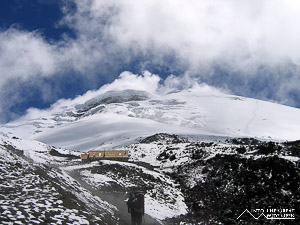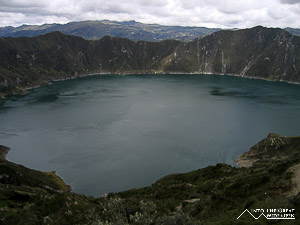Latacunga, Ecuador
The Volcano and Crater Lake
January 17, 2008
The clouds around your soul don't gather there for nothing
- Oasis

Latacunga is two hours south of Quito by bus. It is not a very charming town in any regard but a convenient one for visiting the nearby Cotopaxi Volcano, the highest active volcano in the world. On a clear day the volcano towers over the city to its south, but those clear days are not so common. So with some reluctance I walked to one of the tour operators in the rain and signed up for a tour to go see the volcano the next day. When I asked if the weather was going to be clear tomorrow the answer I received was an expression in Spanish that translates literally to: the weather is like a woman.
On the morning of the tour the weather looked decent, it wasn´t raining and the sky seemed to be clearing. Our first stop was at a weekly market in a nearby town, which had the usual collection of animals, foods, and what would commonly be termed junk. After that we proceeded to the national park via a rough dirt road. It was still impossible to see the volcano as it was totally shrouded in clouds. As we rounded the volcano and approached it from the north side, the clouds began to clear and we finally got a view of the summit and the rest of the mountain. It was a nice view as the volcano has a near perfect conical shape with an interesting snow line. After taking some photos we drove up to the parking area, which is at 4,500 meters elevation, and then hiked up to the refuge at 4,800 meters.

It was quite steep and tiring because of the altitude and we passed many people carrying their climbing gear up to the refuge. It is popular to climb to the top but you need to use crampons and an ice axe along with other gear to make the ascent. I decided against climbing to the top because they didn´t have boots in my size, the largest size being two sizes too small, and I would have had to leave at 1am with 50 other people in a single file line for the 5-6 hour climb with a chance of the summit being totally shrouded in clouds. It seemed like a better experience to just hike up to the refuge. Even though we were over 15,000 feet in elevation, when the sun was out and the wind wasn´t blowing, you could have laid out as if you were at the beach. When the clouds blocked the sun and the wind picked up it felt only a few degrees above freezing with the wind chill.

Up around the snow line there were three wolves scavenging for food. The wolves weren´t bothered by the Ecuadorean military taking photos with their camera phones only 10 feet away. Before we started to descend the clouds drifted back in and soon the peak was covered in clouds, talking to some other people who had done the climb a few days before I discovered that our group was actually quite fortunate to have seen anything at all.
To the west of Latacunga is the town of Zumbahua, famous for its market; and the nearby town of Quilotoa perched on the rim of a spectacular crater lake. I took the bus to Quilotoa and the scenery was great once the bus left Latacunga behind and got out into the countryside. There were llamas grazing on the slopes of mountains with cell phone towers on top and I saw a bridge made from a single tree trunk with hand ropes next to the well paved road.

After two hours of winding through these mountain roads and dropping off indigenous people in the middle of nowhere to reach their farming plots the bus reached Zumbahua. The town had about 8 streets and I was very glad that I had decided to go straight to Quilotoa rather than spend the night in Zumbahua; I have no idea what I would have done the rest of the day. It was only 12 km farther to Quilotoa, and those 12 km seemed to be straight vertical. When the bus arrived at the town, being the lone tourist on the bus I had to purchase the $1 tourist ticket to enter the town. The town consisted of about 4 hotels, all including breakfast and dinner because there were no restaurants in town save for two houses advertising that they served lunch. There was a basketball court, for some reason, and a few houses scattered here and there and that was about it.
I walked around the rim of the crater for a little ways and then hiked down to the lake, which was down over a thousand feet on a really steep path. After some time on the bottom I made the climb back up which was much more tiring than the climb down. As the sun started to set it began to get cold and the wind picked up as well. Most of the people that lived up there wrapped scarves over their faces when they walked outside to keep the dust and wind off their faces. Dinner consisted of a piece of chicken and rice, they were nice enough to cut up the chicken so that I got the piece of the spine right behind the neck so that there was exactly one piece of edible meat on it. Because they didn´t have any kindling left for the wood stove in my room and the bigger damp wood wouldn´t light I had to sleep under the thick blankets to ward off the cold night-time temperatures.

In the morning a pickup truck that had wooden benches installed in the back and functioned as mini-bus drove four of us back to Zimbahua. On a bus leaving the market I had the privilege of seeing what must have been at least a 200 pound pig on the roof struggling to stay upright as its hooves skidded on the metal while the bus navigated the windy mountain road. How said pig made its way to the roof of the bus I am not sure. On my return bus to Latacunga I saw a lamb being hauled up to the roof by its leg and then down again later along the route. Lucky for me and the other passengers I guess the livestock are not permitted to ride inside the buses in Ecuador.

















































































